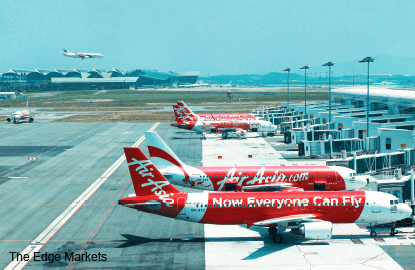
This article first appeared in The Edge Malaysia Weekly, on March 7 - 13, 2016.
 TUCKED away in a corner at klia2, opposite fast-food restaurant Burger King, is AirAsia Bhd’s interim office. The low-cost carrier (LCC) is set to move to its new corporate office, next to Tune Hotel in Sepang, in October. The entrance of its makeshift home is dimly lit but the office is bustling with the kind of urgency that has become familiar to the AirAsia brand.
TUCKED away in a corner at klia2, opposite fast-food restaurant Burger King, is AirAsia Bhd’s interim office. The low-cost carrier (LCC) is set to move to its new corporate office, next to Tune Hotel in Sepang, in October. The entrance of its makeshift home is dimly lit but the office is bustling with the kind of urgency that has become familiar to the AirAsia brand.
In a hurry to catch a flight out of Malaysia for a business trip, the LCC’s CEO, Aireen Omar, gives swift but elaborate answers to questions on the company’s operations and its most recent quarterly financial results. The future of LCCs is bright and the AirAsia group, she promises, is well-positioned to serve an Asian market hungry for air travel.
However, some things don’t change. At the mention of AirAsia’s relationship with the country’s airport operator, Malaysia Airports Holdings Bhd (MAHB), which has a near monopoly, she pauses before letting loose a long sigh, betraying a trace of exasperation.
Aireen says, “I don’t know what to say.”
AirAsia and MAHB have an unusual business relationship — mutually dependent but frequently disagreeing. The difference in opinion between the two sides — ranging from operational issues such as changes to the check-in system, terminals and airport charges to safety concerns over the infrastructure at klia2 — is often played out publicly.
Aireen describes the current communication between AirAsia and MAHB as “inconsistent” and says “it should be easier”.
“There should be a mindset change in terms of assisting and facilitating the growth of the biggest client of the airport, to understand the needs of the client and to ensure that [changes] are being made, and that they are done speedily.
“What they (MAHB) can do better is to engage and listen more to the needs of the industry … understanding the requirements for growth. Airlines bring in the traffic — they (airlines) know better and they are closer to the market,” she says.
Failure to change the current operational habits, Aireen warns, will risk the growth of klia2 as a regional hub for LCCs.
“We hope that MAHB can improve the facilities at klia2 … We have to do something quickly,” she adds.
At the peak of AirAsia’s discontent, the LCC demanded from the airport operator RM409 million for losses arising from the budget airline’s operations at klia2 and the former low-cost carrier terminal (LCCT) in Sepang, Selangor. Through a letter of demand, AirAsia alleged, among others, that MAHB had breached its contractual duties and duty of care, and damaged AirAsia’s brand.
The list of breaches identified by AirAsia included MAHB’s failure to address over-capacity problems in the LCCT, to provide sufficient aircraft parking bays in the terminal and to consult airline operators on klia2’s development and expansion.
AirAsia also alleged that MAHB failed to maintain and operate a secure, safe and efficient airport, to keep klia2 in good repair and condition, to effect repairs and/or maintenance at klia2, to consult the airline on prices charged before changes in the charging system were introduced, and to promote the interest of users in respect of prices charged.
Other airlines operating at LCC have not shared AirAsia’s views on klia2 and MAHB.
AirAsia is MAHB’s largest customer at klia2, providing 80% of the passenger traffic there. AirAsia, with its wide national network, also has a significant presence in many of MAHB’s secondary hubs such as Langkawi, Kota Kinabalu, Kuching and Johor Baru. Being the biggest customer, AirAsia would naturally expect MAHB to cater for its needs all the time.
MAHB has openly answered these allegations. The feuding parties have also met to discuss solutions at the prompting of the Ministry of Transport. Such talks, though, can do little to soothe years of suspicion and disappointment.
AirAsia’s concern is not misplaced. According to a publication by CAPA — Centre for Aviation, Bangkok’s Don Muang Airport (DMK) has grown to become the world’s largest LCC airport, overtaking Kuala Lumpur International Airport (KLIA) (formerly Asia’s largest LCC airport), Barcelona-El Prat Airport and Las Vegas’ McCarran International Airport in the first half of last year. During the period, DMK saw 13.4 million passengers versus an estimated 12.6 million passengers at KLIA.
“To put the two markets in perspective, there are currently 87 LCC aircraft based at KLIA, compared with 86 aircraft at the beginning of 2015. At DMK, the number of LCC aircraft has increased from 68 at the beginning of 2015 to 80 currently. Market conditions in Malaysia have been more challenging, prompting Southeast Asia’s largest LCC groups AirAsia and Lion Air to focus more on Thailand,” CAPA wrote in a July 2015 report.
Market observers had initially expected the appointment of Aireen as AirAsia’s CEO in 2012 to improve the relationship between the budget airline and the airport operator. The same was said about MAHB managing director Datuk Badlisham Ghazali when he took over from Tan Sri Bashir Ahmad Abdul Majid in June 2014.
While both sides have in the past acknowledged that there is little benefit in continuing a relationship of animosity, the new guard has yet to successfully heal old wounds.
To that, Aireen only quips, “It takes two to tango.”
Save by subscribing to us for your print and/or digital copy.
P/S: The Edge is also available on Apple's AppStore and Androids' Google Play.